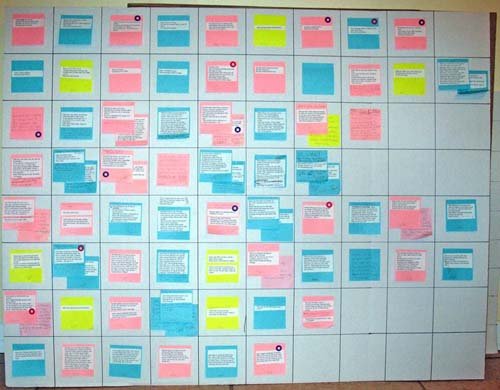My Writing Process

When I write a novel, I plan it all out – that’s how I organise my approach to story writing. If you are a ‘panster’ – someone who just sits down and finds the story as you splurge, this post might not be so useful again. However, if you are a planner, you will love it – I hope.
I am using this post as a general introduction to novel writing. I intend to expand on the process in subsequent posts, to build into a comprehensive series on novel writing.
The specific planning process I use, whilst generally typical of that used by most writers, who plan out their novel before writing, does have some peculiarities specific to my needs and foibles:
Start planning your story basics.
If you scribble basic outlines of each scene/story idea onto scraps of paper or sticky notes, you can literally lay them out before you until they start to make some sort of sense. You will likely have bits missing or maybe not even have an overall story – that’s fine, any order is better than none.
Take time to sketch out you main characters
Who are they? What are they like? What life events have shaped them the way they are? What do they want? Why? What is their past, what are the relationships between them, what strengths and flaws do they have, how will they have changed by the end of the story?

Your Protagonist’s (hero) and your Antagonist (villain) should want the same thing or same goal - that way they are in direct competition. What they want and how they go about getting it, this is the aim of your story.
Try to make the character flaws of your Protagonist the character strengths of your Antagonist, and the character strengths of your Protagonist the character weaknesses of your Antagonist - again putting them in direct conflict.
The flaws in your Protagonist’s character are the things that let them down and get them into trouble. Overcoming one or more character flaws is what leads to ultimate victory or them gaining the thing they want. So make sure you introduce flaws that will lead them into trouble and will need to be overcome?
The strengths in your Antagonist’s character are what gives them victories over your Protagonist. However, failing to overcome one or more of their character flaws is what leads to they ultimate failure or to losing the thing they are after. Make sure your antagonists are not flat – give them some strengths and also flaws they too can overcome?
Take time to think about your overall story
What, in very simple terms is your story, (sum it up in one short sentence) - a much harder exercise than it seems.
How will the main character(s) have evolved from the beginning to the end of the story (One sentence for each character).
Introduce some subplots which might compliment/juxtapose/parody the main story, or which show character growth (one sentence for each).
https://qph.ec.quoracdn.net/main-qimg-cada1c8423ec253c58fb42539fc45fc3-c
If you don’t already know about Story Arcs, do some research, start to fit your stuff from steps (1) & (2) into your main Story Arc. (I will do a full article on story arcs soon).
Start putting everything together
Put everything together for your main story into one straight line in chronological order - lay them out on the floor if you have to, or stick post-it notes to a wall/window/notice board/desk - whatever works for you.

In separate lines lay out the scenes/story ideas for each sub-plot and each character development/story, and decide where they start and finish in relation to the main story.
Now remove every scene and story idea that does not progress the main story.
Use deleted scenes and story ideas for sub plots and character stories. Again, fit them into Story Arcs. If they still don’t fit, save them for the sequels.
Fill in all the gaps with new story ideas and scenes.
Merge all the story lines together.
It may have taken you hours, days, weeks, or even months, to complete this exercise, but you now have an outline plan for your entire novel.
Start writing
Because of my specific needs, I tend to write one chapter at a time, editing the chapter a couple of times until I am happy with it. The skill and craft of writing is really in the editing process - what you do and how you do it will be specific to you. Any additions, alterations or amendments to the plot/story, that occur during the editing process, are recorded on the outline plan and immediately corrected or added to previous chapters (otherwise I will forget about them).
My editing process
First draft: write or dictate a the basic scene/chapter/story. I often use a voice to text software while doing domestic chores or dictate into my mobile while out walking and transpose it to text later).
Scene Brief Edit: Add in as much description and sensory experience as I can (using all five senses), filling in any plot/story gaps.

Grammar Edit: concentrate on sentence, paragraph, and dialogue construction. Sort out grammar and syntax issues.

Sound Edit: this where everyone tells you to read your writing out loud. I find that difficult to do, so I get the computer to read it to me using text-to-speech software. This is where I pick up sound issues and readability issues.
Full read through of the novel with final consistency edits.
Pass out to beta readers for comments and feedback. Make any edits you agree with.
Professional Edit: I pass the manuscript to a US editor I employ. This is party to proofread, partly for a high level copy edit, but mainly to correct British English to US English (the majority of my readers/customers are in the US so I publish my novel in US English).
Novel writing completed
Publish. Repeat with the sequence.
Images
Tom Hanks Gif - giphy.com
The Shape of Story – Diagram by Christiana Wodtke
StoryBoard ericaridley.com
Five senses - pioneerperfume.files.wordpress.com
Other images - unknown
Nice writing tips. I actually wanted to write a fiction novel. Will probably use some of your tips in future. My greatest weakness is probably grammar, so I always put my stuff through that site grammarly.
Grammarly will give you a 'correct' use of grammar, in one of four versions of English - it will help you keep the grammar 'rules'. What it won't help you do, is to artistically 'break the rules', which is an essential element in creating your writer's 'voice'.
I would recommend 'A Dash of Style' by Noah Lukeman as an excellent introduction in how to break the rules.
I never considered putting my writing through text-to-speech to see how it sounds, but that is a great idea.
Thank you!
I just cut and paste into MS word and uses the standard text to voice mode. The great thing is, the voice to text 'reads' the grammar too, so you can really hear how someone else may read your writing. Using this method really helped my writing to 'leap forward' in terms of professionalism.
Thanks for writing this. Im about to start my first novel and ive been struggling to pick the flaw for my lead. The part where you mentioned about the protagonist and antagonist flaws and strengths was eye opening. I never thought about it that way.
Hi, pleased I can help. The essence of story is conflict, so it makes sense to play off the positive and negative characteristics of your characters. The more flaws you include for your main character, the more you can play them off against other characters. I will do a post on character construction soon, but for the moment, one thing to think about: No one thinks of themselves as a villain - everyone is the hero of their own story.
The Novel Writing Workshop:
You can find more of my posts, articles, and stories in My Steemit Library:
Nick
(The link will take you away from Steemit.com, but the library links bring you back again)